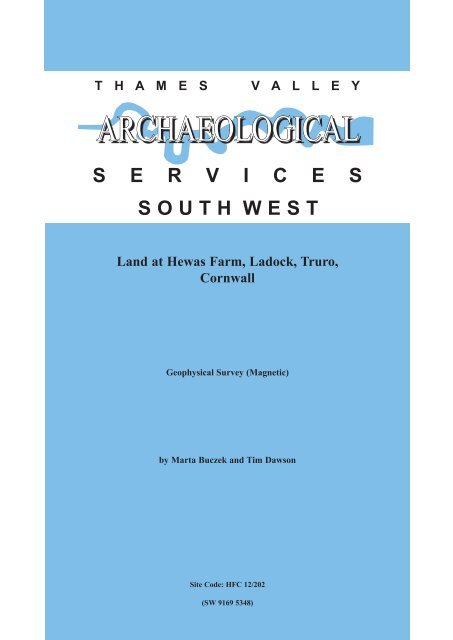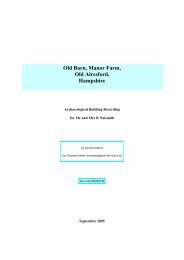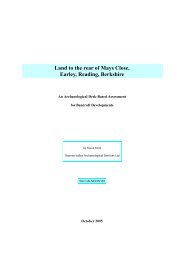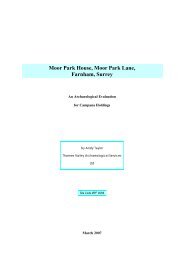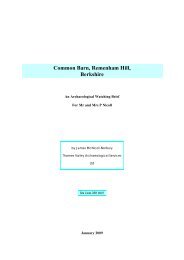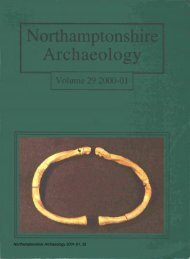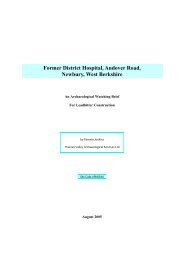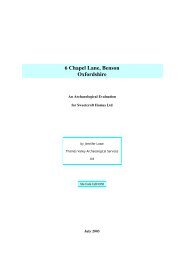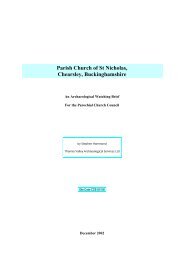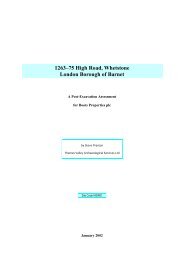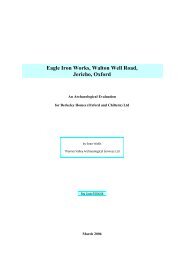Geophysical survey report - Thames Valley Archaeological Services
Geophysical survey report - Thames Valley Archaeological Services
Geophysical survey report - Thames Valley Archaeological Services
You also want an ePaper? Increase the reach of your titles
YUMPU automatically turns print PDFs into web optimized ePapers that Google loves.
T H A M E SV A L L E YARCHAEOLOGICALS E R V I C E SS O U T H W E S TLand at Hewas Farm, Ladock, Truro,Cornwall<strong>Geophysical</strong> Survey (Magnetic)by Marta Buczek and Tim DawsonSite Code: HFC 12/202(SW 9169 5348)
Land at Hewas Farm, Ladock, Truro,Cornwall<strong>Geophysical</strong> Survey (Magnetic) ReportFor ROC Energyby Marta Buczek and Tim Dawson<strong>Thames</strong> <strong>Valley</strong> <strong>Archaeological</strong> <strong>Services</strong> LtdSite Code HFC 12/202December 2012
SummarySite name: Land at Hewas Farm, Ladock, Truro, CornwallGrid reference: SW 9169 5348Site activity: Magnetometer <strong>survey</strong>Date and duration of project: 7th-16th December 2012Project manager: Steve FordSite supervisor: Tim DawsonSite code: HFC 12/202Area of site: 17.5 haSummary of results: Several magnetic anomalies were recorded during the <strong>survey</strong>. Theseinclude features likely to be archaeological in origin. Of particular note are the curvilinearanomalies and the clusters of discreet positive anomalies that may indicate the presence ofdiscrete subsoil features. Additionally, several modern services were identified as well aspossible trackways and field boundaries of unknown date.Location of archive: The archive is presently held at <strong>Thames</strong> <strong>Valley</strong> <strong>Archaeological</strong><strong>Services</strong>, Reading in accordance with TVAS digital archiving policies.This <strong>report</strong> may be copied for bona fide research or planning purposes without the explicit permission of thecopyright holder. All TVAS unpublished fieldwork <strong>report</strong>s are available on our website:www.tvas.co.uk/<strong>report</strong>s/<strong>report</strong>s.asp.Report edited/checked by: Steve Ford 19.12.12Andrew Mundin 19.12.12iTVAS (South West),Unit 21, Apple Business Centre, Frobisher Way, Taunton TA2 6BBTel. (01823) 288 284; Fax (01823) 272 462; email: southwest@tvas.co.uk; website : www.tvas.co.uk
Land at Hewas Farm, Ladock, Truro, CornwallA <strong>Geophysical</strong> Survey (Magnetic)by Marta Buczek and Tim DawsonReport 12/202IntroductionThis <strong>report</strong> documents the results of a geophysical <strong>survey</strong> (magnetic) carried out at land at Hewas Farm, Ladock,Truro, Cornwall (SW 9169 5348) (Fig. 1). The work was commissioned by Mr Stan Dominey of ROC Energy,Satra Innovation Park, Rockingham Road, Kettering, NN16 9JH.Planning consent (PA10/08675) has been gained from Restomel District Council for the development of anew solar farm on agricultural land at Hewas Farm. This is subject to a condition which requires theimplementation of a programme of archaeological work.This is in accordance with the Department for Communities and Local Government’s National PlanningPolicy Framework (NPPF 2012) and the District’s policies on archaeology. The field investigation was carriedout to a specification according to a brief provided by Mr Dan Ratcliffe, Historic Environment Planning AdviceOfficer at Cornwall Council. The fieldwork was undertaken by Marta Buczek, Aiji Castle, Nicholas Dawson andTim Dawson on 7th, 8th, 10th-14th and 16th December and the site code is HFC 12/202.The archive is presently held at <strong>Thames</strong> <strong>Valley</strong> <strong>Archaeological</strong> <strong>Services</strong>, Reading in accordance withTVAS digital archiving policies.Location, topography and geologyThe site is located along the eastern edge of the parish of Ladock, at its border with the parish of St Stephen inBrannel, c.13km northeast of Truro (Fig. 1). It lies c.400m east of Lower Hewas Farm and 3km northeast ofLadock village and is bounded by Melbur China Clay Works to the north and Tresillian river valley to the west.The site lies at between 85m and 115m above Ordnance Datum (aOD) on land sloping down to the south andwest totalling an area of approximately 17.5 hectares. It is situated in a landscape bisected by river valleys to theeast and west, rising to a plateau interspersed with operational china clay workings to the north. The site itselfwas subdivided into six fields (A to F, Fig. 2) planted with grass and clover. The underlying geology is describedas Meadfoot Beds (calcareous slate, grit and thin limestone) (BGS 1982).1
The site and weather conditions during the <strong>survey</strong> period were mainly dry with strong winds (Plates 1-4).However, the area was subjected to a few prolonged periods of overnight rain and some heavy showers duringthe day. Despite this the ground remained firm with water only temporarily pooling on the surface.Site history and archaeological backgroundPart of the site may have a potential for remains of round barrows dating to the Bronze Age. This potential issuggested by the historic field name ‘burrow close’ and also by the historic landscape character of the easternparts of this site. This land can be described as ‘Early Modern Enclosed Land’ (Ratcliffe 2012) and is likely torepresent intensification of land formerly characterised by rough ground used in the medieval period as commongrazing. Such areas have an elevated potential for prehistoric ritual features such as round barrows, standingstones, later prehistoric settlements and earlier medieval field systems. The western parts of the site arecharacterised by ‘Anciently Enclosed Land’ (Ratcliffe 2012), i.e. land enclosed during the medieval period orearlier. The existing field boundaries in this area suggest medieval enclosure of former common strips of land.The Cornwall Historic Environment Record indicates at least two probable Iron Age settlements to the south andeast of the site area.MethodologySample intervalData collection required a temporary grid to be established across the <strong>survey</strong> area using wooden pegs at 30mintervals with further subdivision where necessary. Readings were taken at 0.25m intervals along traverses 1mapart. This provides 3600 sampling points across a full 30m × 30m grid (English Heritage 2008), providing anappropriate methodology balancing cost and time with resolution. An initial grid plan was drawn up to cover theentirety of the site with the grid in each field being aligned to the field’s long axis. The plan was largely followed(Fig. 2) although several adjustments were made to overcome obstacles encountered on site. These obstaclesincluded flooding in the south-western corners of Fields A and C, the thickness of the hedgerows which dividedthe various fields, and heavy farm traffic along the boundaries of Fields B, D, E and F. These all had the effect ofreducing the area available for <strong>survey</strong>.The Grad 601-2 has a typical depth of penetration of 0.5m to 1.0m. This would be increased if stronglymagnetic objects have been buried in the site. Under normal operating conditions it can be expected to identifyburied features >0.5m in diameter. Features which can be detected include disturbed soil, such as the fill of a2
ditch, structures that have been heated to high temperatures (magnetic thermoremnance) and objects made fromferro-magnetic materials. The strength of the magnetic field is measured in nano Tesla (nT), equivalent to 10 -9Tesla, the SI unit of magnetic flux density.EquipmentThe purpose of the <strong>survey</strong> was to identify geophysical anomalies that may be archaeological in origin in order toinform a targeted archaeological investigation of the site prior to development. The <strong>survey</strong> and <strong>report</strong> generallyfollow the recommendations set out by both English Heritage (2008) and the Institute for Archaeologists (2002).Magnetometry was chosen as a <strong>survey</strong> method as it offers the most rapid ground coverage and responds toa wide range of anomalies caused by past human activity. These properties make it ideal for fast yet detailed<strong>survey</strong> of an area.The detailed magnetometry <strong>survey</strong> was carried out using a dual sensor Bartington Instruments Grad 601-2fluxgate gradiometer. The instrument consists of two fluxgates mounted 1m vertically apart with a second setpositioned at 1m horizontal distance. This enables readings to be taken of both the general background magneticfield and any localised anomalies with the difference being plotted as either positive or negative buried features.All sensors are calibrated to cancel out the local magnetic field and react only to anomalies above or below thisbase line. On this basis, strong magnetic anomalies such as burnt features (kilns and hearths) will give a highresponse as will buried ferrous objects. More subtle anomalies such as pits and ditches, can be seem from theirinfilling soils containing higher proportions of humic material, rich in ferrous oxides, compared to theundisturbed subsoil. This will stand out in relation to the background magnetic readings and appear in planfollowing the course of a linear feature or within a discrete area.A Trimble GeoXH 6000 handheld GPS system with sub-decimetre accuracy was used to tie the site gridinto the Ordnance Survey national grid. This unit offers both real-time correction and post-<strong>survey</strong> processing;enabling a high level of accuracy to be obtained both in the field and in the final post-processed data.Data gathered in the field was processed using the ArcheoSurveyorLite software package. This allows the<strong>survey</strong> data to be collated and manipulated to enhance the visibility of anomalies, particularly those likely to beof archaeological origin. The table below lists the processes applied to this <strong>survey</strong>, full <strong>survey</strong> and datainformation is recorded in Appendix 1.3
ProcessDe-stagger all grids by -2 intervalsDe-stripe all grids using median valuesClip from -20.00 to 20.00 nTEffectRemoves the staggering effect caused by variations inspeed resulting from obstructions (e.g. wind, gradient)in the <strong>survey</strong>or’s path.Corrects for the striped effect caused by changes insensor setup.Enhance the contrast of the image to improve theappearance of possible archaeological anomalies.Once processed, the results are presented as a greyscale plot shown in relation to the site (Figs 3, 4 and 5),followed by a second plan to present the abstraction and interpretation of the magnetic anomalies (Fig. 6).Anomalies are shown as colour-coded lines, points and polygons. The grid layout and georeferencinginformation (Fig. 2, Appendix 2) is prepared in EasyCAD v.7.22.01, producing a .FC7 file format, and printed asa .PDF for inclusion in the final <strong>report</strong>.The greyscale plot of the processed data is exported from ArcheoSurveyorLite in portable network graphics(.PNG) format, a raster image format chosen for its lossless data compression and support for transparent pixels,enabling it to easily be overlaid onto an existing site plan. The data plot is rotated to orientate it to north andcombined with grid and site plans in Adobe InDesign CS5.5, creating .INDD file formats. Once the figures arefinalised they are exported in .PDF format for inclusion within the finished <strong>report</strong>.ResultsThe magnetic data from all six fields indicate a level of disturbance by ploughing. This can be seen in the strongpositive, and in some places negative, parallel lines along the long axis of each field. These have not beenincluded within the interpretation, to highlight other more significant archaeological, rather than agriculturalanomalies.Field AA large number of strong positive anomalies were recorded during <strong>survey</strong>ing. These are more likely to be ofarchaeological origin. Two curvilinear features located in the northern part of the <strong>survey</strong> area roughly are alignedeast-west parallel to each other and represent ditch-type anomalies [Fig. 6: A1]. A second set of linear positiveanomalies, located in the southern part of the field, also aligned east-west parallel to each other giving theappearance of a trackways [A2]. It may also suggest an extension of the field boundary that separates Fields B, Cand D to the southeast (Fig. 6). Another ditch-type positive anomaly [A3] located in the centre of the field4
traverses both [A1] and [A2] . To the north, [A3] turns sharply to the west to form [A4], another ditch-typepositive anomaly with an associated negative response. They may represent part of an enclosure [A4].A strong bipolar anomaly (composed of alternating positive and negative responses) located in the northernpart of the field running roughly in a northwest-southeast direction represents a modern ferrous pipeline [A5].Other weak background variations can be seen to the southeast of the field. They appear slightly curvy andsinuous in form and are likely to be result of natural features such as soil creep [A6].Unidentified weak negative anomalies occur in the south and north of the field, appearing as a pair ofdotted parallel lines. These are possibly of archaeological origin although they more likely represent modernvehicle tracks [A7].Parallel to the northern and to the southern boundaries there are two weak positive anomalies which mayrepresent archaeological features but it is more likely that they just signify the presence of old field boundaries[A8].The site is sparsely scattered with spots of strong positive magnetic disturbance which caused by ferrousdebris.Field BA ditch-type positive anomaly roughly aligned across the field in a northeast-southwest is possibly ofarchaeological origin [B1]. To the southeast of this there is another strong magnetic signature anomaly whichslightly curves to the north [B2]. Another positive anomaly with a weaker signal can also be identified in thesouthern part of the <strong>survey</strong>ing field [B3] and is parallel to [B1]. On the field side to the southwest edge there is astrong positive ditch type anomaly which can also be seen continuing in Field A [A1, B4] (Fig. 6).From the southeastern corner of the field on a northwest-southeast axis runs a linear bipolar anomaly whichseems to be a modern pipeline [B5] and which can also be seen in Field A [A5]. More strong positive magneticanomalies can be seen in northern and western part of the field forming a line that is aligned roughly north-southand may be of archaeological (pits, tree boles) or geological origin [B6]. A series of unidentified anomaliesoccur in the southern and in the northern part of the field. These are similar to these found in Field A and alsoappear as a dotted paralleled lines, and may also suggest a trackway [B7].Parallel to the northern and southern boundaries are two weak positive anomalies which may representarchaeological features, but are more likely to just signify the presence of old field boundaries [B8]. Magneticscatters can be identified in the northern part of the field and may be caused by ferrous objects.5
Field CThe primary feature of Field C is a pair of strong negative linear anomalies with a strong positive anomalylocated in the space between [C1]. This is aligned on a north-south axis and is likely to represent an oldboundary system as it appears to be a continuation of the existing boundaries between Fields C and D (Fig. 4).An irregular linear positive anomaly aligned roughly east-west is most likely to be of geological origin, e.g.a channel or soil creep [C2]. It is probably a continuation of the similar feature identified in Field A [A6].The unidentified negative track-like anomalies also appear in this field forming a regular half oval shapethat curves down from the northern boundary [C3]. As with the previous examples, these could be ofarchaeological origin but are more likely modern.To the east and west end of the field occur weak positive anomalies forming regular lines which suggestmovement of the field boundaries [C4].Magnetic scatters can be identified in the eastern and western part of the field and may be caused by ferrousobjects.Field DAn intersecting group of four strong positive linear anomalies were recorded within Field D. One ditch-typeanomaly is aligned northeast-southwest [D1], a possible continuation of [B1], and a second cuts across it in anorthwest-southeast direction before turning to a more southerly course [D2]. These may both be ofarchaeological origin and might represent ancient enclosures but more likely they just signify the presence of oldfield boundaries. These are both intersected by a continuation of the ditch-type anomaly from Field B [B2, D3],which continues to curve around to the north. Another short section of positive anomaly [D4] runs parallel to[D3] before crossing [D2]. A final set of positive linear anomalies can be seen running parallel to the extant fieldboundary along the eastern, western and southern edges of the field [D5, D6, D7] and most likely represent analteration to the hedgerows.The distinctive features of Field D are the clusters of discreet positive anomalies c.2m in diameter that canbe seen particularly in the north and southeast of the field [D8, Fig. 7: D9]. These might be caused by discretesubsoil anomalies, such as pits or tree boles, or naturally occurring depressions in the ground (solution hollows).An alternate, more detailed, explanation for the anomalies, particularly those that form overall linear shapes, isthat they may be pits dug for mining shallow mineral deposits. The signals in the north of the field [D8] appearto be more regular in shape forming an oval and suggest a structure with its entrance from the north side. A tight6
group of strong localised bipolar and negative magnetic responses can be seen within the oval and suggest eitherbuilt-up or fired structures such as ovens, furnaces or hearths.Several other discreet positive anomalies are dotted around the field, not appearing to form part of anylarger groupings.Field E (Fig. 7)A linear positive anomaly can be seen clearly aligned northeast-southwest has potential to be of archaeologicalorigin [Fig. 7: E1]. However, excavations occurring on site during the <strong>survey</strong> to reroute a water pipe showed thatthis anomaly was in fact the water pipe that was being rerouted. A second strong positive linear anomaly isorientated parallel to the first in the southeast corner of the field [E2]. This one, however, is much wider and ismore likely to be archaeological in origin. Another strong positive anomaly can be seen in south-western cornerof the field [E3] and appears to be an extension of the probable geological feature also seen in Fields A and C[Fig. 6: A6, C3].Further positive anomalies but with weaker magnetic signatures can be seen to the south of the field alignedon east-west axis [E4] and to the north of the field aligned north-south [E5] and are possibly archaeological inorigin.A single strong localised magnetic response can be seen on the eastern boundary of the field, its appearancesuggesting magnetic disturbance caused by a near-by ferromagnetic object [E6]. A series of parallel lines similarto those found in Fields A, B and C also occur in Field E, again suggesting vehicle tracks [E7].Field FField F is characterised by two sets of linear positive anomalies which are broadly aligned north-south along thefield’s long axis. The first of these is a single strong anomaly accompanied by several sections of weaker parallellinear anomaly [F1] which can be interpreted as possible field boundaries or a trackway and are potentially ofarchaeological origin. To the east a second pair of stronger positive anomalies forms a more convincingtrackway leading northwards from the field’s south-eastern corner [F2]. Both of these sets of features are crossedby several fragmentary positive linear anomalies. In the west [F3], an apparent continuation of [E2], crosses [F1]and then possibly appears again in the north joining [F2]. A second linear anomaly [F4] leads from the westernboundary eastwards across the field, crossing [F1] but disappearing before it reaches [F2]. In the north a curvedanomaly [F5] appears to respect the line of [F2] but a second, slightly weaker anomaly [F6] cuts perpendicularlyacross it curving northwards into the magnetic disturbance caused by a modern pipe [F7].7
Elsewhere in the field, several discreet positive anomalies c.2m in diameter and similar to those noted inField D can be identified across the area. Of particular interest is the linear concentration of these anomalies [F8]to the south of the centre of the field. Again, these may be archaeological pits or tree boles or they may representpits dug for mineral extraction.Along the eastern edge of the field along its edge there is a distinctive linear bipolar anomaly signifying thepresence of a modern pipe [F7]. A similar area of disturbance can be seen in the south-western corner of the field[F9]. This was caused by the close proximity of parked plant during the <strong>survey</strong>. Several ferrous spikes can alsobe identified; these appear to be a sparse scatter of iron objects across the field, either of archaeological ormodern in origin.ConclusionThe <strong>survey</strong> undertaken across the six fields at Hewas Farm successfully identified anomalies representingseveral cut features that are possibly of archaeological origin. These primarily consist of linear features whichoccasionally intersect each other to suggest several phases of land use. Those less likely to be archaeological inorigin represent more modern changes in field layout. Of interest are the concentrations of positive anomaliesthat indicate the presence of pit-like features. These clusters, particularly those in Field D, may signifyarchaeological activity or structures or, alternately, mineral extraction operations. An organic-looking positiveanomaly was recorded in the lowest area of site and might represent a naturally occurring buried channel orchange in geology. The <strong>survey</strong> area is crossed by several modern pipelines, the magnetic signatures of whichwill have had a masking effect on and near-by anomalies, particularly along the site’s eastern boundary. Otheranomalies of modern origin include what are likely to be vehicle tracks crossing several of the fields.ReferencesBGS, 1982, British Geological Survey, 1:50,000, Sheet 347, Solid and Drift Edition, KeyworthEnglish Heritage, 2008, <strong>Geophysical</strong> Survey in <strong>Archaeological</strong> Field Evaluation, English Heritage, Portsmouth(2nd edn)IFA, 2002, The Use of <strong>Geophysical</strong> Techniques in <strong>Archaeological</strong> Evaluation, IFA Paper No. 6, ReadingNPPF, 2012, National Planning Policy Framework, Dept Communities and Local Government, LondonRatcliffe, D, 2012, Brief for <strong>Archaeological</strong> Programme of work at Hewas Farm, Lacock, Truro. CornwallCouncil HES, Truro8
Appendix 1. Survey and data informationPROGRAMMEName:ArcheoSurveyorVersion: 2.5.19.6Field ARaw dataCOMPOSITEFilename: Field 1.xcpInstrument Type: Bartington (Gradiometer)Units:nTSurveyed by: Aiji Castle, Tim Dawson on 07/12/2012Assembled by: Aiji Castle on 07/12/2012Direction of 1st Traverse: 0 degCollection Method: ZigZagSensors:2 @ 1.00 m spacing.Dummy Value: 32000DimensionsComposite Size (readings): 1200 x 150Survey Size (meters): 300 m x 150 mGrid Size: 30 m x 30 mX Interval: 0.25 mY Interval: 1 mStatsMax: 100.00Min: -100.00Std Dev: 10.62Mean: -1.61Median: -1.78Composite Area: 4.5 haSurveyed Area: 2.0681 haSource Grids: 351 Col:0 Row:1 grids\01.xgd2 Col:0 Row:2 grids\14.xgd3 Col:1 Row:1 grids\02.xgd4 Col:1 Row:2 grids\15.xgd5 Col:2 Row:1 grids\03.xgd6 Col:2 Row:2 grids\16.xgd7 Col:3 Row:1 grids\04.xgd8 Col:3 Row:2 grids\17.xgd9 Col:3 Row:3 grids\24.xgd10 Col:4 Row:0 grids\05.xgd11 Col:4 Row:1 grids\06.xgd12 Col:4 Row:2 grids\18.xgd13 Col:4 Row:3 grids\25.xgd14 Col:5 Row:0 grids\07.xgd15 Col:5 Row:1 grids\08.xgd16 Col:5 Row:2 grids\19.xgd17 Col:5 Row:3 grids\26.xgd18 Col:5 Row:4 grids\31.xgd19 Col:6 Row:0 grids\09.xgd20 Col:6 Row:1 grids\10.xgd21 Col:6 Row:2 grids\20.xgd22 Col:6 Row:3 grids\27.xgd23 Col:6 Row:4 grids\32.xgd24 Col:7 Row:1 grids\11.xgd25 Col:7 Row:2 grids\21.xgd26 Col:7 Row:3 grids\28.xgd27 Col:7 Row:4 grids\33.xgd28 Col:8 Row:1 grids\12.xgd29 Col:8 Row:2 grids\22.xgd30 Col:8 Row:3 grids\29.xgd31 Col:8 Row:4 grids\34.xgd32 Col:9 Row:1 grids\13.xgd33 Col:9 Row:2 grids\23.xgd34 Col:9 Row:3 grids\30.xgd35 Col:9 Row:4 grids\35.xgdProcessed dataStatsMax: 20.00Min: -20.00Std Dev: 7.39Mean: 0.14Median: 0.00Processes: 41 Base Layer2 De Stagger: Grids: All Mode: Both By: -2 intervals3 DeStripe Median Sensors: All4 Clip from -20.00 to 20.00 nTField BRaw dataCOMPOSITEFilename: grids unprocessed.xcpInstrument Type: Bartington (Gradiometer)Units:nTSurveyed by: Aiji Castle, Tim Dawson on 08/12/2012Assembled by: Tim Dawson on 10/12/2012Direction of 1st Traverse: 0 degCollection Method: ZigZagSensors:2 @ 1.00 m spacing.Dummy Value: 32000DimensionsComposite Size (readings): 720 x 120Survey Size (meters): 180 m x 120 mGrid Size: 30 m x 30 mX Interval: 0.25 mY Interval: 1 mStatsMax: 100.00Min: -100.00Std Dev: 12.04Mean: 3.79Median: 3.49Composite Area: 2.16 haSurveyed Area: 1.4947 haSource Grids: 201 Col:0 Row:0 grids\01.xgd2 Col:0 Row:1 grids\07.xgd3 Col:0 Row:2 grids\13.xgd4 Col:1 Row:0 grids\02.xgd5 Col:1 Row:1 grids\08.xgd6 Col:1 Row:2 grids\14.xgd7 Col:2 Row:0 grids\03.xgd8 Col:2 Row:1 grids\09.xgd9 Col:2 Row:2 grids\15.xgd10 Col:3 Row:0 grids\04.xgd11 Col:3 Row:1 grids\10.xgd12 Col:3 Row:2 grids\16.xgd13 Col:4 Row:0 grids\05.xgd14 Col:4 Row:1 grids\11.xgd15 Col:4 Row:2 grids\17.xgd16 Col:4 Row:3 grids\19.xgd17 Col:5 Row:0 grids\06.xgd18 Col:5 Row:1 grids\12.xgd19 Col:5 Row:2 grids\18.xgd20 Col:5 Row:3 grids\20.xgdProcessed dataStatsMax: 20.00Min: -20.00Std Dev: 7.31Mean: 0.39Median: 0.009
Processes: 41 Base Layer2 DeStripe Median Sensors: All3 De Stagger: Grids: All Mode: Both By: -2 intervals4 Clip from -20.00 to 20.00 nTField CRaw dataCOMPOSITEFilename: grids.xcpInstrument Type: Bartington (Gradiometer)Units:nTSurveyed by: Marta Buczek, Tim Dawson on 11/12/2012Assembled by: Marta Buczek on 11/12/2012Direction of 1st Traverse: 90 degCollection Method: ZigZagSensors:2 @ 1.00 m spacing.Dummy Value: 32000DimensionsComposite Size (readings): 1080 x 150Survey Size (meters): 270 m x 150 mGrid Size: 30 m x 30 mX Interval: 0.25 mY Interval: 1 mStatsMax: 100.00Min: -100.00Std Dev: 8.43Mean: -1.39Median: -1.48Composite Area: 4.05 haSurveyed Area: 1.911 haSource Grids: 301 Col:0 Row:1 grids\17.xgd2 Col:1 Row:0 grids\19.xgd3 Col:1 Row:1 grids\18.xgd4 Col:1 Row:2 grids\10.xgd5 Col:1 Row:3 grids\01.xgd6 Col:2 Row:0 grids\20.xgd7 Col:2 Row:1 grids\21.xgd8 Col:2 Row:2 grids\11.xgd9 Col:2 Row:3 grids\02.xgd10 Col:3 Row:1 grids\22.xgd11 Col:3 Row:2 grids\12.xgd12 Col:3 Row:3 grids\03.xgd13 Col:4 Row:1 grids\23.xgd14 Col:4 Row:2 grids\13.xgd15 Col:4 Row:3 grids\04.xgd16 Col:5 Row:0 grids\24.xgd17 Col:5 Row:1 grids\25.xgd18 Col:5 Row:2 grids\14.xgd19 Col:5 Row:3 grids\05.xgd20 Col:5 Row:4 grids\06.xgd21 Col:6 Row:0 grids\26.xgd22 Col:6 Row:1 grids\27.xgd23 Col:6 Row:2 grids\15.xgd24 Col:6 Row:3 grids\07.xgd25 Col:6 Row:4 grids\08.xgd26 Col:7 Row:0 grids\28.xgd27 Col:7 Row:1 grids\29.xgd28 Col:7 Row:2 grids\16.xgd29 Col:7 Row:3 grids\09.xgd30 Col:8 Row:0 grids\30.xgdProcessed dataStatsMax: 20.00Min: -20.00Std Dev: 6.92Mean: 0.27Median: 0.001 Base Layer2 De Stagger: Grids: All Mode: Both By: -2 intervals3 De Stagger: Grids: SubGrid (Area: Top 70, Left 480, Bottom75, Right 599) Mode: Both By: 2 intervals4 De Stagger: Grids: SubGrid (Area: Top 84, Left 480, Bottom89, Right 599) Mode: Both By: -2 intervals5 De Stagger: Grids: SubGrid (Area: Top 94, Left 480, Bottom97, Right 599) Mode: Both By: -1 intervals6 De Stagger: Grids: SubGrid (Area: Top 38, Left 480, Bottom41, Right 599) Mode: Outbound By: -1 intervals7 De Stagger: Grids: SubGrid (Area: Top 32, Left 480, Bottom33, Right 599) Mode: Both By: -1 intervals8 DeStripe Median Sensors: All9 Clip from -20.00 to 20.00 nTField DRaw dataCOMPOSITEFilename: grids.xcpInstrument Type: Bartington (Gradiometer)Units:nTSurveyed by: Marta Buczek, Tim Dawson on 12/12/2012Assembled by: Tim Dawson on 12/12/2012Direction of 1st Traverse: 0 degCollection Method: ZigZagSensors:2 @ 1.00 m spacing.Dummy Value: 32000DimensionsComposite Size (readings): 1080 x 240Survey Size (meters): 270 m x 240 mGrid Size: 30 m x 30 mX Interval: 0.25 mY Interval: 1 mStatsMax: 99.34Min: -72.16Std Dev: 8.14Mean: -5.11Median: -5.35Composite Area: 6.48 haSurveyed Area: 3.3156 haSource Grids: 451 Col:0 Row:3 grids\13.xgd2 Col:0 Row:4 grids\21.xgd3 Col:1 Row:2 grids\07.xgd4 Col:1 Row:3 grids\14.xgd5 Col:1 Row:4 grids\22.xgd6 Col:1 Row:5 grids\30.xgd7 Col:2 Row:1 grids\01.xgd8 Col:2 Row:2 grids\08.xgd9 Col:2 Row:3 grids\15.xgd10 Col:2 Row:4 grids\23.xgd11 Col:2 Row:5 grids\31.xgd12 Col:2 Row:6 grids\38.xgd13 Col:3 Row:1 grids\02.xgd14 Col:3 Row:2 grids\09.xgd15 Col:3 Row:3 grids\16.xgd16 Col:3 Row:4 grids\24.xgd17 Col:3 Row:5 grids\32.xgd18 Col:3 Row:6 grids\39.xgd19 Col:4 Row:1 grids\03.xgd20 Col:4 Row:2 grids\10.xgd21 Col:4 Row:3 grids\17.xgd22 Col:4 Row:4 grids\25.xgd23 Col:4 Row:5 grids\33.xgd24 Col:4 Row:6 grids\40.xgd25 Col:5 Row:0 grids\04.xgd26 Col:5 Row:1 grids\05.xgd27 Col:5 Row:2 grids\11.xgd28 Col:5 Row:3 grids\18.xgd29 Col:5 Row:4 grids\26.xgd30 Col:5 Row:5 grids\34.xgd31 Col:5 Row:6 grids\41.xgd10
32 Col:6 Row:1 grids\06.xgd33 Col:6 Row:2 grids\12.xgd34 Col:6 Row:3 grids\19.xgd35 Col:6 Row:4 grids\27.xgd36 Col:6 Row:5 grids\35.xgd37 Col:6 Row:6 grids\42.xgd38 Col:6 Row:7 grids\43.xgd39 Col:7 Row:3 grids\20.xgd40 Col:7 Row:4 grids\28.xgd41 Col:7 Row:5 grids\36.xgd42 Col:7 Row:6 grids\44.xgd43 Col:8 Row:4 grids\29.xgd44 Col:8 Row:5 grids\37.xgd45 Col:8 Row:6 grids\45.xgdProcessed dataStatsMax: 20.00Min: -20.00Std Dev: 6.53Mean: 0.29Median: 0.00Processes: 41 Base Layer2 DeStripe Median Sensors: All3 De Stagger: Grids: All Mode: Both By: -2 intervals4 Clip from -20.00 to 20.00 nTField ERaw dataCOMPOSITEFilename: grids.xcpInstrument Type: Bartington (Gradiometer)Units:nTSurveyed by: Marta Buczek, Tim Dawson on 14/12/2012Assembled by: Tim Dawson on 14/12/2012Direction of 1st Traverse: 0 degCollection Method: ZigZagSensors:2 @ 1.00 m spacing.Dummy Value: 32000DimensionsComposite Size (readings): 1080 x 150Survey Size (meters): 270 m x 150 mGrid Size: 30 m x 30 mX Interval: 0.25 mY Interval: 1 mStatsMax: 100.00Min: -100.00Std Dev: 6.61Mean: 2.40Median: 2.91Composite Area: 4.05 haSurveyed Area: 2.6246 haSource Grids: 341 Col:0 Row:0 grids\01.xgd2 Col:0 Row:1 grids\02.xgd3 Col:0 Row:2 grids\09.xgd4 Col:0 Row:3 grids\18.xgd5 Col:0 Row:4 grids\27.xgd6 Col:1 Row:1 grids\03.xgd7 Col:1 Row:2 grids\10.xgd8 Col:1 Row:3 grids\19.xgd9 Col:1 Row:4 grids\28.xgd10 Col:2 Row:1 grids\04.xgd11 Col:2 Row:2 grids\11.xgd12 Col:2 Row:3 grids\20.xgd13 Col:2 Row:4 grids\29.xgd14 Col:3 Row:1 grids\05.xgd15 Col:3 Row:2 grids\12.xgd16 Col:3 Row:3 grids\21.xgd17 Col:3 Row:4 grids\30.xgd18 Col:4 Row:1 grids\06.xgd19 Col:4 Row:2 grids\13.xgd20 Col:4 Row:3 grids\22.xgd21 Col:4 Row:4 grids\31.xgd22 Col:5 Row:1 grids\07.xgd23 Col:5 Row:2 grids\14.xgd24 Col:5 Row:3 grids\23.xgd25 Col:5 Row:4 grids\32.xgd26 Col:6 Row:1 grids\08.xgd27 Col:6 Row:2 grids\15.xgd28 Col:6 Row:3 grids\24.xgd29 Col:6 Row:4 grids\33.xgd30 Col:7 Row:2 grids\16.xgd31 Col:7 Row:3 grids\25.xgd32 Col:7 Row:4 grids\34.xgd33 Col:8 Row:2 grids\17.xgd34 Col:8 Row:3 grids\26.xgdProcessed dataStatsMax: 20.00Min: -20.00Std Dev: 4.36Mean: 0.19Median: 0.00Processes: 41 Base Layer2 De Stagger: Grids: All Mode: Both By: -2 intervals3 DeStripe Median Sensors: All4 Clip from -20.00 to 20.00 nTField FRaw dataCOMPOSITEFilename:Instrument Type:Units:grids.xcpBartington (Gradiometer)nTMarta Buczek, Nicholas Dawson, TimSurveyed by:Dawson on 17/12/2012Assembled by: Tim Dawson on 17/12/2012Direction of 1st Traverse: 0 degCollection Method: ZigZagSensors:2 @ 1.00 m spacing.Dummy Value: 32000DimensionsComposite Size (readings): 1080 x 180Survey Size (meters): 270 m x 180 mGrid Size: 30 m x 30 mX Interval: 0.25 mY Interval: 1 mStatsMax: 100.00Min: -100.00Std Dev: 24.85Mean: 0.58Median: 0.72Composite Area: 4.86 haSurveyed Area: 3.1141 haSource Grids: 441 Col:0 Row:0 grids\44.xgd2 Col:1 Row:0 grids\43.xgd3 Col:1 Row:1 grids\29.xgd4 Col:1 Row:2 grids\28.xgd5 Col:1 Row:3 grids\13.xgd6 Col:1 Row:4 grids\01.xgd7 Col:2 Row:0 grids\42.xgd8 Col:2 Row:1 grids\30.xgd9 Col:2 Row:2 grids\27.xgd10 Col:2 Row:3 grids\14.xgd11 Col:2 Row:4 grids\02.xgd11
12 Col:2 Row:5 grids\03.xgd13 Col:3 Row:0 grids\41.xgd14 Col:3 Row:1 grids\31.xgd15 Col:3 Row:2 grids\26.xgd16 Col:3 Row:3 grids\15.xgd17 Col:3 Row:4 grids\05.xgd18 Col:3 Row:5 grids\04.xgd19 Col:4 Row:0 grids\40.xgd20 Col:4 Row:1 grids\32.xgd21 Col:4 Row:2 grids\25.xgd22 Col:4 Row:3 grids\16.xgd23 Col:4 Row:4 grids\06.xgd24 Col:4 Row:5 grids\07.xgd25 Col:5 Row:0 grids\39.xgd26 Col:5 Row:1 grids\33.xgd27 Col:5 Row:2 grids\24.xgd28 Col:5 Row:3 grids\17.xgd29 Col:5 Row:4 grids\08.xgd30 Col:5 Row:5 grids\09.xgd31 Col:6 Row:0 grids\38.xgd32 Col:6 Row:1 grids\34.xgd33 Col:6 Row:2 grids\23.xgd34 Col:6 Row:3 grids\18.xgd35 Col:6 Row:4 grids\10.xgd36 Col:7 Row:0 grids\37.xgd37 Col:7 Row:1 grids\35.xgd38 Col:7 Row:2 grids\22.xgd39 Col:7 Row:3 grids\19.xgd40 Col:7 Row:4 grids\11.xgd41 Col:8 Row:1 grids\36.xgd42 Col:8 Row:2 grids\21.xgd43 Col:8 Row:3 grids\20.xgd44 Col:8 Row:4 grids\12.xgdProcessed dataStatsMax: 20.00Min: -20.00Std Dev: 7.59Mean: 0.05Median: -0.08Processes: 101 Base Layer2 De Stagger: Grids: All Mode: Both By: -1 intervals3 DeStripe Median Sensors: All4 Clip from -30.00 to 30.00 nT5 De Stagger: Grids: All Mode: Both By: -1 intervals6 DeStripe Median Sensors: All7 Clip from -30.00 to 30.00 nT8 Edge Match (Area: Top 120, Left 600, Bottom 149, Right 719)to Left edge9 Edge Match (Area: Top 120, Left 600, Bottom 149, Right 719)to Top edge10 Clip from -20.00 to 20.00 nTAppendix 2. Georeferencing information(see Fig. 2 for tie-in locations)A1 191378.823 E 53525.129 NA2 191433.345 E 53550.034 NB1 191453.136 E 53557.649 NB2 191509.566 E 53577.982 NC1 191618.879 E 53386.267 NC2 191676.443 E 53403.320 ND1 191671.098 E 53557.611 ND2 191694.696 E 53612.635 NE1 191769.520 E 53460.127 NE2 191829.020 E 53451.675 NF1 191902.333 E 53444.220 NF2 191961.752 E 53435.744 N12
55000BudeNewquayBodminLiskeardTruroSt AustellPenzanceSITE54000SITE53000SW91000 92000Land at Hewas Farm, Ladock, Truro,Cornwall, 2012<strong>Geophysical</strong> Survey (Magnetic)Figure 1. Location of site at Hewas Farm, and its locationin relation to Truro, within Cornwall.Reproduced from Ordnance Survey Explorer 106 at 1:12500Ordnance Survey Licence 100025880HFC 12/202
Field DField B53600Field AA1 0603060A26060B106060300303060B26060D10-30D200030300600Field F535005340060000-6030C1-3030060C203000-60E1 30-30300600E2 3000-6030F1-3030030F20006053300FloodedField CSiteField ESW 91400 91500 91600 91700 91800 91900 92000HFC 12/202NLand at Hewas Farm, Ladock, Truro,Cornwall, 2012<strong>Geophysical</strong> Survey (Magnetic)Figure 2. Grid layout.0 100m
53600060306060606030060030306060600-3000030300600535005340060000-6030-303006003000-6030-303006003000-6030-30300006003053300SW91400 91500 91600 91700 91800 91900 92000NNLand at Hewas Farm, Ladock, Truro,Land at Hewas Farm, Ladock, Truro,Cornwall, 2012Cornwall, 2012<strong>Geophysical</strong><strong>Geophysical</strong>SurveySurvey(Magnetic)(Magnetic)Figure 2. Grid layout.Figure 3. Plot of processed data.+20 nTHFC 12/202HFC 12/2020 100m0m200m-20 nT
53600030060306060606030060030306060600-3000300535006000006053400-6030-30300300053300SW91400 91500 91600HFC 12/202NLand at Hewas Farm, Ladock, Truro,Cornwall, 2012<strong>Geophysical</strong> Survey (Magnetic)Figure 4. Plot of processed data for the western half of the site.+20 nT0m100m-20 nT
536000300-300030060053500060053400-3030060030-6030-303000030-6030-3030000600300053300SW91700 91800 91900HFC 12/202NLand at Hewas Farm, Ladock, Truro,Cornwall, 2012<strong>Geophysical</strong> Survey (Magnetic)Figure 5. Plot of processed data for the eastern half of the site.+20 nT0m100m-20 nT
LegendPositive anomaly - possible cutfeature (archaeology)Weak positive anomaly -possible cut feature53600Negative anomaly - possibleearthwork (archaeology)Weak negative anomaly -possible earthwork or trackPositive anomaly - probably ofgeological originFerrous spike - probable ferrousobjectMagnetic disturbance caused bynearby metal objects/services060A5A83060A760606030060030B73060B6B86060B1D6D3D4D1D2D80-3000030D93005350060A1 000B4B2A4B5B7D7B3A7A3B806053400A2A7A6C2C3C1-6030C2-3030030C400C4A853300NSW91400 91500 91600Land at Hewas Farm, Ladock, Truro,Cornwall, 2012<strong>Geophysical</strong> Survey (Magnetic)Figure 6. Interpretation plot for the western half of the site.HFC 12/2020m100m
LegendPositive anomaly - possible cutfeature (archaeology)Weak positive anomaly -possible cut featureD853600030D5Negative anomaly - possibleearthwork (archaeology)Weak negative anomaly -possible earthworkPositive anomaly - probably ofgeological originFerrous spike - probable ferrousobjectMagnetic disturbance caused bynearby metal objects/servicesD20-3000D9300D5600E5E7F6F553500060F2053400-3030060C4030E1-6030-3030E600030F3F4-6030-3030F800060030F7C300E3E4E2F1F953300NSW91700 91800 91900Land at Hewas Farm, Ladock, Truro,Cornwall, 2012<strong>Geophysical</strong> Survey (Magnetic)Figure 7. Interpretation plot for the eastern half of the site.HFC 12/2020m100m
Plate 1. Field A in the foreground, looking southeasttowards Fields C, E and F.Plate 2. Field A in the foreground, looking east throughField B into D, E and F.Plate 3. Field C, looking southwest with Fields A and B inthe beyond.Plate 4. Field D, looking east.HFC 12/202Land at Hewas Farm, Ladock, Truro,Cornwall, 2012<strong>Geophysical</strong> Survey (Magnetic)Plates 1 to 4.
TIME CHARTCalendar YearsModern AD 1901Victorian AD 1837Post Medieval AD 1500Medieval AD 1066Saxon AD 410Roman AD 43BC/ADIron Age750 BCBronze Age: LateBronze Age: MiddleBronze Age: Early1300 BC1700 BC2100 BCNeolithic: LateNeolithic: Early3300 BC4300 BCMesolithic: LateMesolithic: Early6000 BC10000 BCPalaeolithic: UpperPalaeolithic: MiddlePalaeolithic: Lower30000 BC70000 BC2,000,000 BC


